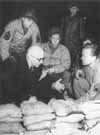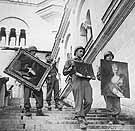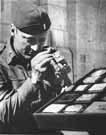
|
|
|

|

|

|

|
|
Click on an image to see a larger, more detailed picture.
|
|
|
|
|
| 1945: Liberation and Rebuilding |

|
pg. 616 |

|
|
|
|
| |
 A German Reichsbank official and U.S. Third Army troops examine bags of European currency hidden deep within a salt mine. This hiding place, one of many maintained by the Nazis, also yielded an estimated 100 tons of gold bullion and several art treasures. Nazi policy sanctioned the looting of billions of dollars worth of gold and other goods from Jewish and Christian owners. Most of the gold came from the national banks of occupied nations, but some derived from the gold teeth and personal possessions of exterminated victims of the Holocaust. We now know that governments and national banks of some neutral nations, especially Switzerland, helped launder looted gold, aiding the German war effort.
A German Reichsbank official and U.S. Third Army troops examine bags of European currency hidden deep within a salt mine. This hiding place, one of many maintained by the Nazis, also yielded an estimated 100 tons of gold bullion and several art treasures. Nazi policy sanctioned the looting of billions of dollars worth of gold and other goods from Jewish and Christian owners. Most of the gold came from the national banks of occupied nations, but some derived from the gold teeth and personal possessions of exterminated victims of the Holocaust. We now know that governments and national banks of some neutral nations, especially Switzerland, helped launder looted gold, aiding the German war effort.
Photo: Hulton Getty Images
|
 U.S. Seventh Army soldiers carry a few of the priceless paintings discovered in Neuschwanstein Castle in Bavaria. This loot had been earmarked for an art gallery at Linz, Austria, where Hitler had spent much of his childhood. The pieces were collected on the orders of Hermann Göring, Nazi Germany's leading art thief.
U.S. Seventh Army soldiers carry a few of the priceless paintings discovered in Neuschwanstein Castle in Bavaria. This loot had been earmarked for an art gallery at Linz, Austria, where Hitler had spent much of his childhood. The pieces were collected on the orders of Hermann Göring, Nazi Germany's leading art thief.
Photo: Hulton Getty Images
|
 The Nazis elevated looting to the level of a dark art form, appropriating virtually everything of value that fell within their grasp. As the Reich crumbled early in 1945, the Allies discovered increasing numbers of Nazi caches of valuables. Here, First Lieutenant James Rorimer of the U.S. Seventh Army examines a tray of stolen antique jewelry, gold snuff boxes, and other items uncovered at Bavaria's Neuschwanstein Castle.
The Nazis elevated looting to the level of a dark art form, appropriating virtually everything of value that fell within their grasp. As the Reich crumbled early in 1945, the Allies discovered increasing numbers of Nazi caches of valuables. Here, First Lieutenant James Rorimer of the U.S. Seventh Army examines a tray of stolen antique jewelry, gold snuff boxes, and other items uncovered at Bavaria's Neuschwanstein Castle.
Photo: AP/Wide World
|
|

|

|

|

|
 Late April 1945: Photographic images of the concentration camp at Bergen-Belsen, Germany, are widely circulated in Great Britain.
Late April 1945: Photographic images of the concentration camp at Bergen-Belsen, Germany, are widely circulated in Great Britain.
|
 May 1945: After 68 months of war, just one of every ten of Poland's prewar Jewish population of 3.3 million is alive.
May 1945: After 68 months of war, just one of every ten of Poland's prewar Jewish population of 3.3 million is alive.
|
 May 1945: Thirty thousand prisoners transported from Mauthausen, Austria, and Warsaw revolt at the labor camp at Ebensee, Austria. When they are ordered into a tunnel packed with explosives, they refuse to budge, confusing the SS and Volksdeutsche guards, all of whom are mindful of the advancing Allies and the likelihood of war-crimes trials. The prisoners' defiance is successful and they are left unharmed.
May 1945: Thirty thousand prisoners transported from Mauthausen, Austria, and Warsaw revolt at the labor camp at Ebensee, Austria. When they are ordered into a tunnel packed with explosives, they refuse to budge, confusing the SS and Volksdeutsche guards, all of whom are mindful of the advancing Allies and the likelihood of war-crimes trials. The prisoners' defiance is successful and they are left unharmed.
|
|
|
|
|
| 1945: Liberation and Rebuilding |

|
pg. 616 |

|
|
The Holocaust Chronicle
© 2009 Publications International, Ltd.
|
|
